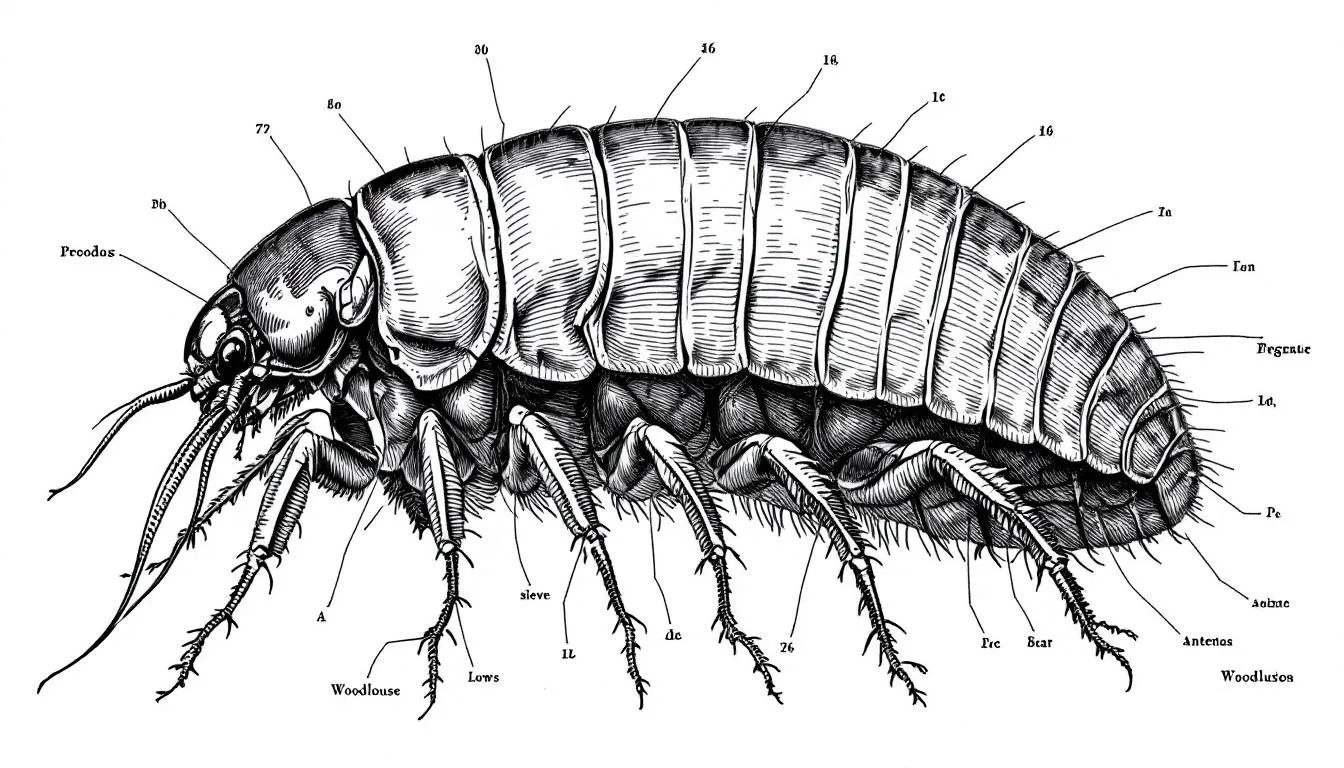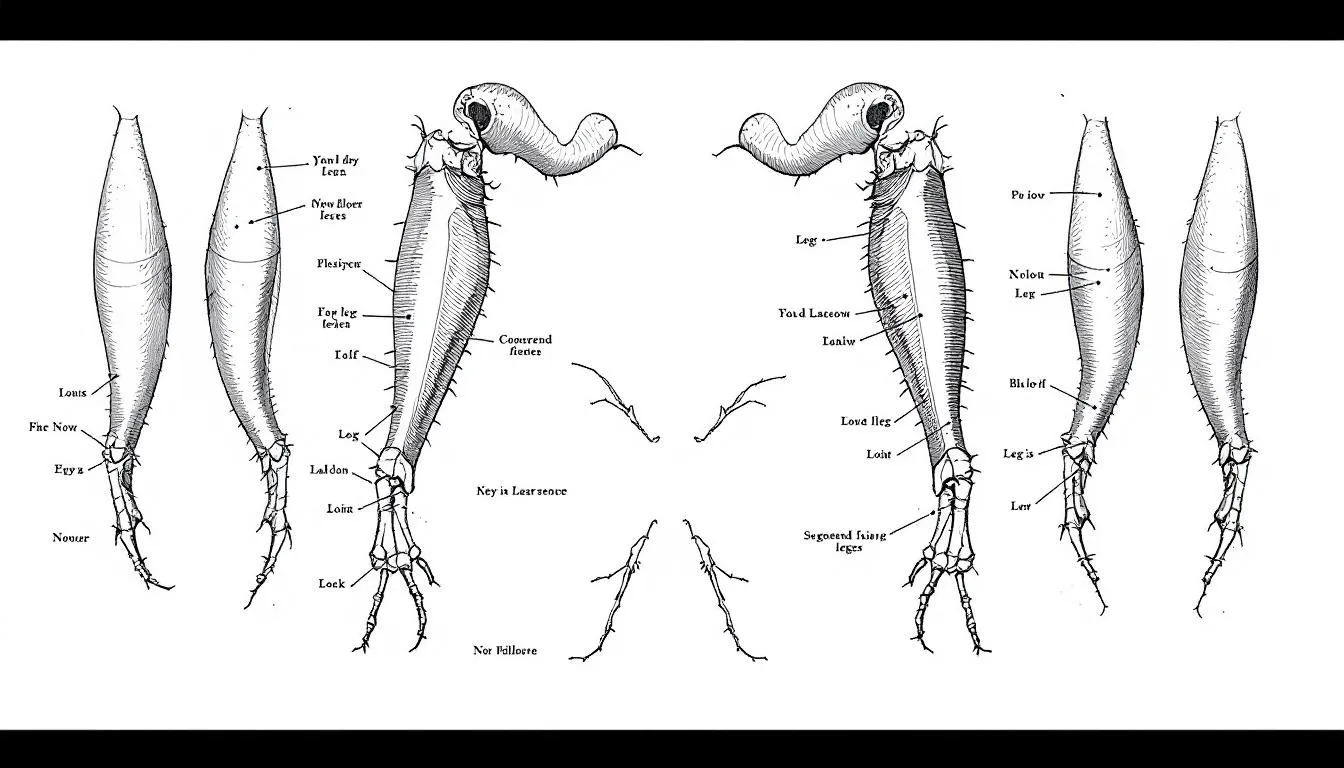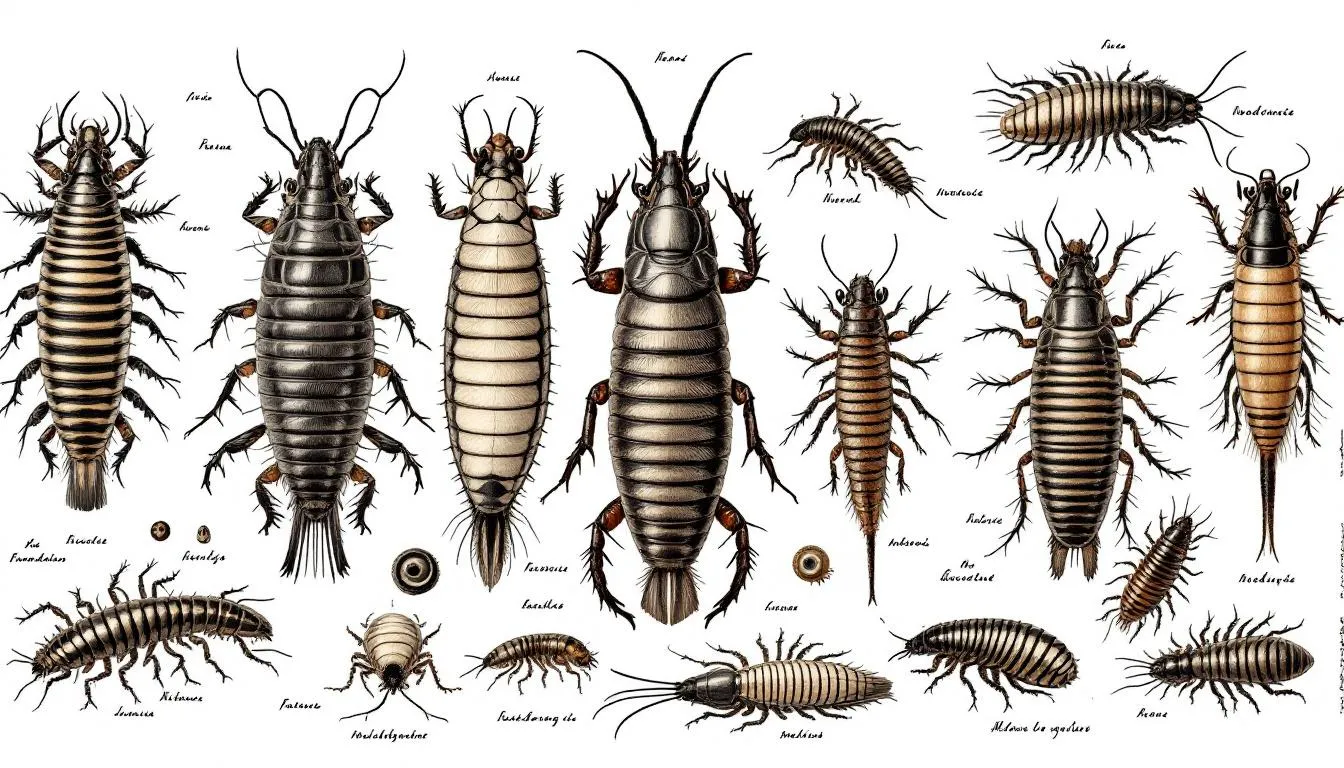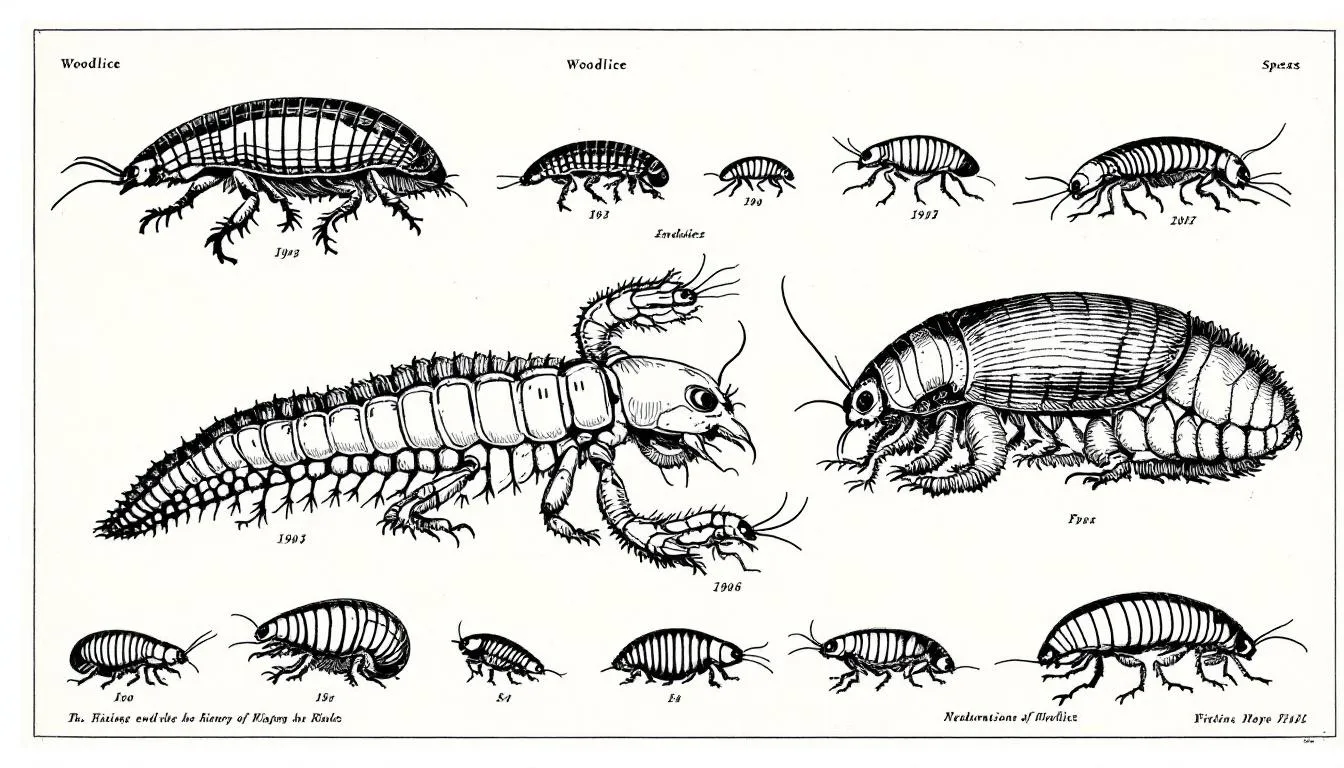Woodlouse anatomy shows how these creatures have adapted to land. In this article, we’ll cover their exoskeleton, body segments, and breathing mechanisms.
Key Takeaways
-
Woodlice have unique adaptations, including a thick exoskeleton and pleopodal lungs, that facilitate survival in terrestrial environments and minimize water loss.
-
Their anatomy, consisting of segmented bodies and fourteen uniramous legs, enhances mobility and supports their role as detritivores in the ecosystem.
-
The evolutionary journey of woodlice from marine ancestors to terrestrial creatures highlights their adaptability and intricate interactions within their habitats.
External Anatomy of Woodlice

The external anatomy of woodlice is a testament to their adaptation to terrestrial life. At the forefront is their thick and bumpy exoskeleton, which serves as a formidable shield against physical damage and water loss. This exoskeleton is not just a protective barrier, but a crucial factor in the woodlice’s ability to retain moisture in their often dry habitats.
Woodlice are equipped with two pairs of antennae, each serving distinct functions. The longer antennae are adept at detecting environmental vibrations, helping the woodlice navigate through their surroundings. The shorter antennae, on the other hand, function as chemoreceptors, allowing these creatures to sense chemicals in their environment and aiding in their search for food.
The compound eyes of woodlice, though small, are highly effective. These eyes enable woodlice to perceive light and movement, which is essential for their nocturnal activities. Detecting changes in light and shadows allows woodlice to forage and avoid predators under the cover of darkness.
Segmentation and Body Parts
Woodlice have a body that is divided into two main sections: the thorax and the abdominal segments. The thorax, or pereon, consists of seven segments, each bearing a pair of legs. This segmentation is crucial for their movement and structural integrity.
The back section, referred to as the pleon, is involved in respiratory functions. Each thoracic segment has its own pair of legs, supporting locomotion and providing stability and flexibility as woodlice navigate various terrains.
Legs and Movement

Woodlice possess fourteen legs, organized in seven pairs, that play a vital role in their movement. These legs have the following characteristics:
-
They are uniramous, meaning each leg is a single, unbranched structure.
-
They are more suitable for terrestrial life compared to the biramous legs of their aquatic crustacean relatives.
-
This adaptation allows woodlice to move efficiently across uneven surfaces, which is essential in their natural habitats.
Each pair of legs enhances the woodlice’s ability to traverse various terrains, ensuring both stability and flexibility. This is particularly important as they navigate through leaf litter, soil, and decaying wood, environments that are often full of obstacles. The uniramous structure of their legs ensures that they can maintain balance and continue moving even when faced with challenging landscapes.
Beyond movement, the legs also play a role in feeding, as woodlice use them to scrape and manipulate food sources, aiding in their detritivorous diet. This multifunctional use of their legs highlights the efficiency and adaptability of their anatomical structure in the animal kingdom.
Respiratory System
The respiratory system of woodlice is a fascinating adaptation to terrestrial life. They possess specialized structures known as pleopodal lungs, which are located on the lower segments of their abdomen. These lungs evolved from gills, a transformation that underscores the evolutionary journey of woodlice from their aquatic ancestors.
Pleopodal lungs in woodlice serve several important functions:
-
Efficiently exchange gases, enabling woodlice to breathe on land.
-
Help minimize water loss, which is crucial for survival in terrestrial environments.
-
Ensure that woodlice can maintain their moisture levels, even in dry conditions.
Reproductive Anatomy
Woodlice exhibit a unique reproductive anatomy that ensures the protection and development of their offspring. Female woodlice have two genital openings located on their abdominal sides, which are used during mating. The mating process involves the male transferring sperm to both of the female’s genital openings in succession, ensuring fertilization.
One of the most fascinating aspects of woodlice reproduction is the brood pouch, or marsupium, found between the female’s legs. This pouch serves as a protective environment for fertilized eggs, where they can develop safely until they hatch, similar to the way a sow bug nurtures its young.
Initially filled with water, the marsupium is later replaced with air as the young woodlice develop the ability to breathe air, facilitating their transition to life outside the pouch.
Internal Anatomy
Internally, woodlice have a straightforward yet efficient digestive system. Unlike many other invertebrates, woodlice lack a midgut. Instead, they rely on caeca for nutrient absorption, which allows them to process food effectively. This simplicity in their digestive system is a testament to the efficiency of their evolutionary design.
The marsupium, or brood pouch, is crucial for young woodlice development:
-
Initially, it is water-filled, providing a safe environment for eggs.
-
As young woodlice develop the ability to breathe air, the marsupium transitions to contain air.
-
This air-filled environment supports their growth until they are ready to venture out.
Adaptations for Terrestrial Life

Woodlice have developed a range of adaptations that enable them to thrive on land. Unlike many other crustaceans, woodlice do not have a waxy layer on their exoskeleton, which makes them more vulnerable to dehydration. This lack of a protective waxy covering influences their habitat preferences, as they tend to seek out moist environments to minimize water loss.
The pleopodal lungs of woodlice function similarly to gills, trapping moisture and facilitating oxygen absorption. Some species have even developed modified structures known as pseudo-trachea, which enhance their oxygen uptake capacity. These adaptations are crucial for their survival in terrestrial habitats.
Preferring dark and moist environments helps woodlice avoid dehydration. They exhibit negative phototaxis, avoiding bright light, and often cluster in groups to reduce water loss. This social behavior not only enhances their survival but also highlights how it reduces water loss and their complex interactions with their environment.
Forming groups and seeking suitable habitats has helped woodlice minimize the challenges of terrestrial living. These adaptations showcase their resilience and ingenuity.
Common Species and Their Anatomical Differences

Among the many species of woodlice, a few stand out due to their distinct anatomical features. The common pygmy woodlouse, for instance, is small, measuring about 5 mm in length, and typically exhibits a purplish-brown or reddish-brown coloration. Unlike other woodlice, it has a distinct conical flagellum that tapers to a point.
The common striped woodlouse is identifiable by its shiny mottled brown appearance and a dark stripe down its back. It is generally about 11 mm long and is known for its striking coloration.
The common rough woodlouse, on the other hand, has a dull, rough exoskeleton and can grow up to 17 mm in length, including the armadillidium vulgare.
Another notable species is the common shiny woodlouse, which is about 16 mm long and features a glossy grey body with yellow patches along its sides. These few species live highlight the diversity within the genus armadillidium and most species of the varying adaptations that have allowed them to thrive in different environments, alongside other arthropods. Common names for these species often reflect their unique characteristics.
Evolutionary History of Woodlice

The evolutionary history of woodlice evolved is a fascinating journey from the sea to the land. Woodlice are believed to have originated from marine isopods that adapted to terrestrial life during the Carboniferous period. Fossil evidence shows that woodlice date back to the mid-Cretaceous, around 100 million years ago, indicating their long evolutionary history.
The distribution and diversity of woodlice fossils suggest that they were already widespread before the breakup of the supercontinent Pangaea. Recent studies indicate that traditional classifications of woodlice may not be fully accurate, as some groups like Ligia are more closely related to marine isopods and their associated many taxa, including the isopod group. This highlights the complexity and ongoing evolution of these remarkable terrestrial crustaceans, which are widely studied and a key focus in invertebrate zoology, including various genera, including the suborder oniscidea and order isopoda, as well as giant isopods.
Interaction with Other Species
Woodlice interact with a variety of species in their environment, with some interactions being quite specialized. The woodlouse spider, known as Dysdera crocata, is one of the few predators that can effectively prey on woodlice. This spider uses its long fangs to pierce the tough exoskeleton of woodlice, making it uniquely adapted to this prey.
Woodlice also play a crucial role in their ecosystems as detritivores, breaking down decaying plant material and recycling nutrients back into the soil. Their legs are essential not only for movement but also for feeding, as they use them to scrape and manipulate food sources.
These interactions highlight the ecological importance of woodlice and their role in maintaining the balance of their habitats. By breaking down organic material and serving as prey for specialized predators, woodlice contribute to the intricate web of life in their ecosystems.
Summary
In summary, the anatomy of woodlice reveals a fascinating story of evolution and adaptation. From their protective exoskeletons and segmented bodies to their specialized respiratory and reproductive systems, woodlice are marvels of nature. Their ability to thrive in terrestrial environments despite the challenges they face is a testament to their resilience and ingenuity.
Studying woodlice not only enhances our understanding of these unique creatures but also underscores the interconnectedness of life. By appreciating the complexities of woodlice anatomy, we gain insights into the broader tapestry of life on Earth. Let us continue to explore and marvel at the wonders of the natural world.
Frequently Asked Questions
What is the function of the pleopodal lungs in woodlice?
Pleopodal lungs serve to enhance gas exchange while reducing water loss, which is crucial for the survival of woodlice in terrestrial habitats.
How do woodlice reproduce?
Woodlice reproduce through a process where the male transfers sperm to the female's two genital openings, after which the fertilized eggs are carried in a brood pouch until they hatch. This method of reproduction allows for the development of young woodlice in a protective environment.
Why do woodlice prefer dark and moist environments?
Woodlice prefer dark and moist environments to prevent dehydration, as they lack a protective waxy layer on their exoskeleton. By residing in such habitats, they can effectively reduce water loss and survive.
What are some common species of woodlice?
Common species of woodlice include the common pygmy woodlouse, common striped woodlouse, common rough woodlouse, and common shiny woodlouse, all of which exhibit distinct anatomical characteristics.
What role do woodlice play in their ecosystems?
Woodlice play a crucial role as detritivores, breaking down decaying plant material and recycling nutrients into the soil, while also serving as prey for predators such as the woodlouse spider. Their activity supports ecosystem health and nutrient cycling.







